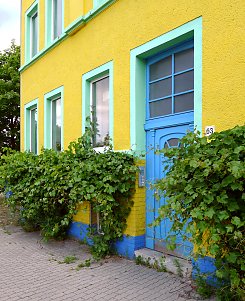Facade Greening Ousts Graffiti!
Graffiti is a problem against which cities often struggle in vain. Climbing trees and shrubs at the base of walls are a super solution -- inexpensive, easy to maintain, and environmentally friendly to boot. Already existing graffiti can, of course, also be covered. Read on to learn more and see some examples.

Preventing Graffiti
"An ounce of prevention is worth a pound of cure." Most of the time, it's sufficient to cover the base / lower areas, but then regular pruning is required. Often support wires, like those in the trellis cable systems 1020, 1060, or 8010, are needed to reign in the stubborn instincts of some plants and affix them to the wall. An easy style / kit is usually sufficient for this. Mural-style painted walls, i.e. plant and floral motifs by artists, are an effective protection against graffiti -- see photo below.

Small grapevines
Graffiti Removal and Greening
Sometimes the damage has already been done...
To protect a freshly de-grafittid wall, trellising roses and pyracantha (scarlet firethorn) can work wonders. It's no fun in the dark for sprayers to run up against their sharp thorns that tear into expensive brand name apparel. Evergreen climbers are interesting here. Small, low-maintenance winter creeper is another good option; it remains limited to the base areas with only moderate growth, yet requires little pruning.
Concealing Graffiti
Removing graffiti is expensive, and its stucco or protective coatings may be removed with the grafitti in the process. This or the painting itself can reduce the wall's natural breathability, hindering the water vapor permeability, which in turn can lead to delamination/spalling in certain kinds of masonry. It may then be better to leave the graffiti on the wall and to conceal it by greening over it. Ivy, Virginia creeper, and Boston ivy can quickly cover a wall. Be aware though-- uncontrolled growth can lead to eventual structural damage, namely in buildings where construction or plaster is already compromised.




















